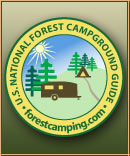Forest Information
The Caribou National Forest is located in the southeastern
portion of Idaho and is comprised of 972,565 acres. There are
over 20 developed campgrounds of which 10 meet the selection
criteria.
The Caribou National Forest was not named for a member of the deer family. That's right – graceful and hardy caribou never roamed the mountains and plains of what is now called Caribou National Forest. The Forest was named for the tall-tales-telling miner named Cariboo Jack. (His real name was Jesse Fairchild.) In 1870, Cariboo Jack and two fellow miners discovered gold near what is now the Caribou Mountains. This gold rush lasted 20 years, producing 50 million dollars worth of placer gold, and opened the area up to settlement. Today, much of the land roamed by Cariboo and his fellow miners is dotted with nice Forest Service managed camping locations surrounded by the magnificent southern Idaho landscaped.
Just before Cariboo Jack's discovery, the first Government-built wagon road in the west was completed. Named the Lander Trail, this road provided pioneers traveling west with a cutoff from the Oregon Trail to California. With the discovery of gold in Idaho, Lander Trail provided easy access to the new gold fields for those who wanted to try their hand at the dream. Listed on the National Register of Historic Places, visitors can still see deep ruts made by wagons in the soil and find scattered carvings in aspen groves made by pioneers using Lander Trail. Located in the Webster Range, northeast of Mill Canyon campground, time spent exploring Lander Trail will add to one's appreciation of the trials and accomplishments of our pioneering past.
The time spent at most of the Caribou National Forest's campgrounds will recall tales of our pioneering past. At campgrounds like Mill Canyon, with woods of pine and fir trees next to a steep mountainside covered in sagebrush, wildlife wanders unafraid, and with clear fast flowing creeks, it only takes the scent of a campfire to imagine Native Americans, wagon trains, miners, settlers and cowboys passing by.
Near the Utah/Idaho border and the 160 square mile Bear Lake, is the attractive St. Charles Canyon. Porcupine and Cloverleaf campgrounds, located in St. Charles Canyon along St. Charles Creek, provides visitors a good base camp to explore the surrounding forest. Or, perhaps they will enjoy the water sports available at Bear Lake. And then there are the raspberry delights offered in Garden City, Utah and the wonders of Minnetonka Cave. There is much to see within this relatively small area.
Minnetonka Cave, in the Bear River Mountains and atop St. Charles Canyon, offers a half-mile adventure in stalactites, stalagmites, and banded travertine below the pine and fir-covered mountains. Guides lead groups of various sizes through several rooms, explaining the how and whys of the Cave, and pointing out special sights and features. No two tours are exactly the same but Minnetonka Cave is a living cave, which means the cave's features are still growing, so the Cave is never exactly the same either. By the way, the Cave's name is not for any tiny buffalo that might have lived there but from the Chippewa People's word for dripping water.
On the other side of Bear River Mountains is a pretty little campground called Willow Flat. A pleasantly rustic campground, Willow Flat stretches along both banks of Cub River in a riparian environment of lush growing maples, cottonwoods, and, of course, willows. This must be one of the most attractive camping locations in the Caribou National Forest when Fall arrives.
Probably the best known and one of the longer trails in the Caribou National Forest, is High Line Trail. Running 55 miles through the Bear River Range, High Line Trail offers hikers special views of the Cache and Bear River valleys while exploring the Forest. Both an intermediate trail head and starting point, Emigration campground has campsites for both through-hikers and transient campers. Emigration also has some well-designed campsites for recreational vehicle users who want to spend a night or more in the cool, dense shade of spruce woods.
The Caribou National Forest is not as large as some national forests in the northwest nor does it have the recreational diversity of its neighboring national forests. It is, however, a quiet undiscovered forest with quality car, tent, motorhome and recreation vehicle (RV) camping, super hiking, and magnificent wildlife viewing opportunities. This Forest takes some effort to get to know but is well-worth every visit.
ADDRESSES
SUPERVISOR ADDRESS
Federal Building
1405 Hollipark Dr.
Idaho Falls, Idaho 83403
208-524-7500
RANGER DISTRICT ADDRESSES
Montpelier
322 North Fourth St.
Montpelier, Idaho 83254
208-847-0375
Soda Springs
421 West 2nd South
Soda Springs, Idaho 83276
208-547-4356
Westside North
415 S. Arthur
Pocatello, Idaho 83201
208-236-7500 |
